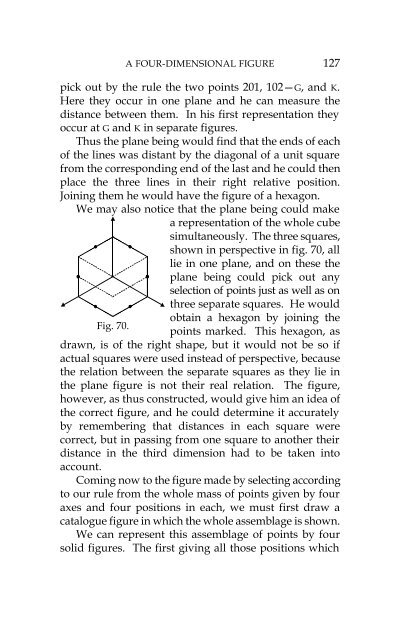You also want an ePaper? Increase the reach of your titles
YUMPU automatically turns print PDFs into web optimized ePapers that Google loves.
A FOUR-DIMENSIONAL FIGURE 127<br />
pick out by the rule the two points 201, 102—G, and K.<br />
Here they occur in one plane and he can measure the<br />
distance between them. In his first representation they<br />
occur at G and K in separate figures.<br />
Thus the plane being would find that the ends of each<br />
of the lines was distant by the diagonal of a unit square<br />
from the corresponding end of the last and he could then<br />
place the three lines in their right relative position.<br />
Joining them he would have the figure of a hexagon.<br />
We may also notice that the plane being could make<br />
a representation of the whole cube<br />
simultaneously. <strong>The</strong> three squares,<br />
shown in perspective in fig. 70, all<br />
lie in one plane, and on these the<br />
plane being could pick out any<br />
selection of points just as well as on<br />
three separate squares. He would<br />
Fig. 70.<br />
obtain a hexagon by joining the<br />
points marked. This hexagon, as<br />
drawn, is of the right shape, but it would not be so if<br />
actual squares were used instead of perspective, because<br />
the relation between the separate squares as they lie in<br />
the plane figure is not their real relation. <strong>The</strong> figure,<br />
however, as thus constructed, would give him an idea of<br />
the correct figure, and he could determine it accurately<br />
by remembering that distances in each square were<br />
correct, but in passing from one square to another their<br />
distance in the third dimension had to be taken into<br />
account.<br />
Coming now to the figure made by selecting according<br />
to our rule from the whole mass of points given by four<br />
axes and four positions in each, we must first draw a<br />
catalogue figure in which the whole assemblage is shown.<br />
We can represent this assemblage of points by four<br />
solid figures. <strong>The</strong> first giving all those positions which






![[PDF] Prolegomena](https://img.yumpu.com/16774951/1/190x245/pdf-prolegomena.jpg?quality=85)









